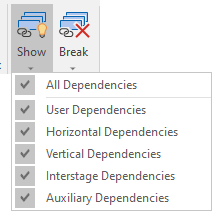Show
![]()

The different dependencies are shown in the Gantt Chart and the Dependencies layer using different colours.
Note that the links between tasks may have a different purpose depending on whether the schedule is a long term schedule or a short term schedule.
In a short term schedule, the links between tasks define a specific (planned) sequence and, unless you specify a lag, the finish date of one task is (typically) assumed to be the start date of the next.
In a long term schedule, the links between tasks (generally) represent dependencies. In other words, a task cannot start until the previous task has been completed. However, there is no implication that the next task will commence immediately after the previous task has finished.
In addition to All dependencies, the following dependency type selections can be made:
| Type | Description |
|---|---|
| User |
User dependencies are the dependencies you create manually in the Gantt Chart or via the sequencing tools on the Scheduling | View ribbon in the Interactive Dependencies group. |
| Horizontal |
In an open pit scenario, horizontal dependencies are created on a bench by bench basis. The principle is that all the tasks on a bench are displayed and then a Start task is chosen. The Start task represents the first block that should be mined on that bench. Once this selection is made, the application automatically generates dependencies between the selected tasks. The links produce a radial pattern extending outwards from the start block. If the Horizontal by Index method is being used, a Block Index attribute must be defined prior to the selection of a Start task. |
| Vertical |
A Vertical dependency for any block requires that the blocks immediately above it need to be mined before it is considered accessible. |
| Interstage |
Interstage dependencies are created when a Stage attribute and a Bench Lag are defined in the Generate Vertical Dependencies dialog. |
| Auxiliary |
Auxiliary dependencies are dependencies between a Primary task and one or more Auxiliary tasks. |
For more information, see: